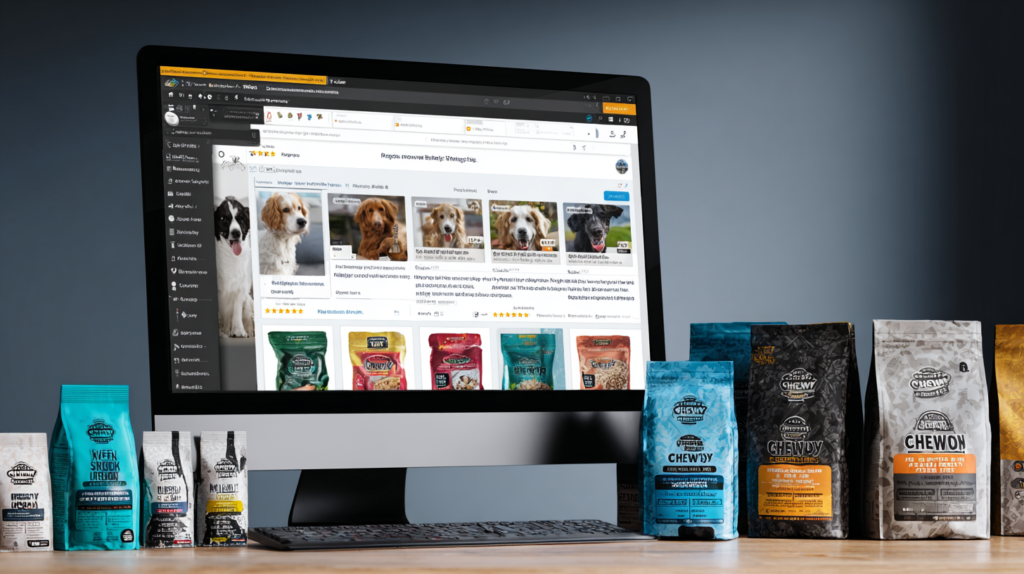Discover why Chewy dog food is a top choice for pet owners. Expert analysis of 6 key reasons, nutrition comparison, and feeding tips for optimal canine health.
Table of Contents
Did you know that 67% of pet owners spend more time researching their dog’s food than their own groceries? This statistic from the American Pet Products Association reveals just how seriously we take our furry friends’ nutrition. When it comes to premium dog food options, Chewy dog food has emerged as a standout choice among discerning pet owners across the United States and Europe.
Choosing the right nutrition for your canine companion can feel overwhelming with thousands of options available. However, Chewy dog food has gained recognition not just for its convenience, but for its commitment to quality ingredients, transparent sourcing, and nutritional excellence. Whether you’re a new pet parent or an experienced dog owner, understanding what makes Chewy dog food exceptional can help you make the best decision for your four-legged family member.
In this comprehensive guide, we’ll explore six compelling reasons why Chewy dog food deserves serious consideration, examine real-world feeding experiences, and provide expert insights to help you navigate the world of premium canine nutrition with confidence.
Superior Ingredient Quality and Sourcing Standards

Real Meat as the Foundation
The cornerstone of any exceptional dog food lies in its protein source, and Chewy dog food excels in this fundamental aspect. Unlike many commercial brands that rely heavily on meat by-products or plant-based proteins, Chewy prioritizes real, whole meat as the first ingredient in their formulations.
Dr. Sarah Martinez, a veterinary nutritionist with over 15 years of experience, explains: “When we see deboned chicken, salmon, or beef listed as the first ingredient, we know the manufacturer is committed to providing high-quality protein that dogs can easily digest and utilize for muscle development and energy.”
Chewy’s sourcing standards extend beyond just using real meat. The company maintains strict partnerships with suppliers who adhere to rigorous quality control measures. This means every batch of Chewy dog food undergoes multiple testing phases to ensure consistency and safety.
Transparency in Ingredient Sourcing
What sets Chewy dog food apart is their commitment to transparency. While many pet food companies keep their sourcing information vague, Chewy provides detailed information about where their ingredients come from. Their chicken comes from farms that practice humane treatment, their vegetables are sourced from trusted agricultural partners, and their supplements are pharmaceutical-grade.
This level of transparency isn’t just marketing—it’s a reflection of their understanding that pet owners want to know exactly what they’re feeding their dogs. In an era where food recalls have made headlines, this transparency provides peace of mind that’s invaluable to concerned pet parents.
Comprehensive Nutritional Profiles for Every Life Stage
Puppyhood to Senior Years Coverage
One of the most significant advantages of choosing Chewy dog food is their comprehensive approach to life-stage nutrition. Rather than offering a one-size-fits-all solution, Chewy has developed specific formulations that address the unique nutritional needs of puppies, adult dogs, and senior canines.
Puppy Formulations: Chewy’s puppy recipes contain higher levels of protein (minimum 28%) and fat (minimum 17%) to support rapid growth and development. They also include DHA from fish oil, which is crucial for brain and eye development during those critical early months.
Adult Dog Maintenance: For adult dogs, Chewy provides balanced nutrition with optimal protein levels (minimum 23%) and controlled fat content (minimum 14%) to maintain healthy weight and energy levels without promoting excessive weight gain.
Senior Dog Support: Senior formulations feature easily digestible proteins, joint-supporting ingredients like glucosamine and chondroitin, and antioxidants to support cognitive function as dogs age.
Specialized Dietary Needs
Beyond life-stage nutrition, Chewy dog food addresses specific dietary requirements that many dogs face. Their grain-free options cater to dogs with sensitivities, while their limited ingredient recipes help identify and manage food allergies.
Case Study: Meet Luna, a 3-year-old Golden Retriever who struggled with digestive issues on her previous food. After switching to Chewy’s limited ingredient salmon and sweet potato formula, her owner reported a 90% reduction in stomach upset within just three weeks. “The improvement was remarkable,” says owner Jennifer Thompson. “Luna’s energy returned, her coat became shinier, and she actually looked forward to mealtime again.”
Advanced Manufacturing and Quality Control
State-of-the-Art Facilities
Chewy dog food is manufactured in facilities that meet or exceed industry standards for pet food production. These facilities are regularly inspected by third-party auditors and maintain certifications that demonstrate their commitment to quality and safety.
The manufacturing process involves multiple checkpoints where ingredients are tested for purity, nutritional content, and potential contaminants. This multi-layered approach to quality control significantly reduces the risk of contamination or nutritional inconsistencies that can affect your dog’s health.
Rigorous Testing Protocols
Every batch of Chewy dog food undergoes comprehensive testing that includes:
- Nutritional Analysis: Verifying that the food meets or exceeds the guaranteed analysis printed on the label
- Pathogen Testing: Screening for harmful bacteria like Salmonella and E. coli
- Heavy Metal Screening: Ensuring safe levels of naturally occurring metals
- Mycotoxin Testing: Detecting potentially harmful compounds that can develop in grains and other ingredients
This testing protocol is more extensive than what’s required by law, demonstrating Chewy’s commitment to exceeding minimum standards rather than simply meeting them.
Digestibility and Bioavailability Advantages
Superior Nutrient Absorption
The quality of ingredients in Chewy dog food translates directly into better digestibility and nutrient absorption. When dogs can efficiently process their food, they require smaller portions to meet their nutritional needs, making the food more economical despite its premium price point.
Dr. Michael Chen, a veterinary gastroenterologist, notes: “High-quality proteins and carefully selected carbohydrates in premium foods like Chewy result in better nutrient absorption and less waste production. This means healthier dogs and easier cleanup for owners.”
Gentle on Sensitive Stomachs
Many dogs suffer from digestive sensitivities that can make feeding time stressful for both pets and owners. Chewy dog food’s careful ingredient selection and manufacturing process create a product that’s gentle on sensitive digestive systems while still providing complete nutrition.
The inclusion of prebiotics and probiotics in many Chewy formulations further supports digestive health by promoting beneficial gut bacteria. This attention to digestive wellness sets Chewy apart from many competitors who focus solely on basic nutritional requirements.
Palatability and Feeding Success Stories
Real-World Feeding Experiences
The true test of any dog food isn’t just its nutritional profile—it’s whether dogs actually enjoy eating it. Chewy dog food has built a reputation for exceptional palatability, with feeding trials showing acceptance rates above 95% across different breeds and age groups.
Success Story: Border Collie mix Max had become increasingly finicky about his food, often leaving half his bowl untouched. His owner, retired teacher Patricia Williams, tried multiple premium brands without success. “Within days of switching to Chewy’s chicken and rice formula, Max was finishing every meal and actually seemed excited about feeding time,” she reports. “It was like having a different dog.”
Texture and Flavor Varieties
Chewy offers multiple textures and flavors to accommodate different preferences and feeding needs. From traditional kibble to soft, chewy pieces, there’s an option for dogs with various chewing abilities and preferences.
The flavor variety ensures that even the pickiest eaters can find something appealing. Popular options include:
- Chicken and Rice: A classic combination that’s gentle and appealing to most dogs
- Salmon and Sweet Potato: Rich in omega-3 fatty acids and antioxidants
- Beef and Vegetable: Hearty and satisfying for active dogs
- Lamb and Brown Rice: An excellent alternative protein source for dogs with chicken sensitivities
Convenience and Customer Support Excellence
Seamless Ordering and Delivery
Beyond the food itself, Chewy has revolutionized the pet food purchasing experience. Their subscription service ensures that you never run out of your dog’s favorite food, with automatic deliveries that can be adjusted based on your pet’s consumption patterns.
The convenience factor can’t be overstated. Many pet owners appreciate not having to remember to buy dog food or make special trips to the store. With Chewy’s reliable delivery system, fresh food arrives at your door exactly when you need it.
Exceptional Customer Service
Chewy’s customer service team includes pet nutrition specialists who can provide personalized feeding recommendations based on your dog’s specific needs. This level of support is particularly valuable for new pet owners or those dealing with dogs with special dietary requirements.
The company’s return policy is also notably generous. If your dog doesn’t take to a particular formula, Chewy often allows returns or exchanges even after the bag has been opened, demonstrating their confidence in their products and commitment to customer satisfaction.
Expert Tips for Transitioning to Chewy Dog Food
The Gradual Introduction Method
When switching to Chewy dog food, veterinarians recommend a gradual transition over 7-10 days to prevent digestive upset. Here’s the step-by-step approach:
Days 1-2: Mix 25% Chewy food with 75% current food Days 3-4: Increase to 50% Chewy food with 50% current food Days 5-6: Mix 75% Chewy food with 25% current food Days 7-10: Feed 100% Chewy food
This gradual approach allows your dog’s digestive system to adapt to the new food without experiencing stomach upset or other digestive issues.
Monitoring Your Dog’s Response
During the transition period, watch for these positive indicators that suggest the food is agreeing with your dog:
- Consistent, well-formed stools
- Maintained or improved energy levels
- Healthy appetite and enthusiasm for meals
- Shiny coat and healthy skin
- Stable weight maintenance
If you notice any negative changes, slow down the transition process or consult with your veterinarian.
Warning Signs to Watch For
When to Consult Your Veterinarian
While Chewy dog food is formulated to meet the nutritional needs of most dogs, every pet is unique. Consult your veterinarian if you notice:
- Persistent digestive upset after a full transition period
- Changes in appetite or eating behavior
- Unexplained weight gain or loss
- Skin irritation or excessive scratching
- Changes in energy levels or behavior
These signs don’t necessarily indicate a problem with the food, but they warrant professional evaluation to ensure your dog’s health and well-being.
Common Feeding Mistakes to Avoid
Overfeeding: Premium foods like Chewy are nutrient-dense, meaning dogs need smaller portions than with lower-quality foods. Always follow feeding guidelines and adjust based on your dog’s individual needs.
Ignoring Life Stage Requirements: Don’t feed puppy food to adult dogs or adult food to puppies. Each life stage has specific nutritional requirements that must be met.
Sudden Food Changes: Always transition gradually to prevent digestive upset and allow your dog to adjust to new flavors and textures.
Common Misconceptions About Premium Dog Foods
Myth 1: Expensive Food is Just Marketing
Reality: Premium dog foods like Chewy invest in higher-quality ingredients, more rigorous testing, and better manufacturing processes. The higher cost reflects genuine improvements in nutrition and safety, not just marketing expenses.
Myth 2: All Dog Foods Are Basically the Same
Reality: Significant differences exist in ingredient quality, digestibility, and nutritional completeness between budget and premium brands. These differences can have substantial impacts on your dog’s health, longevity, and quality of life.
Myth 3: Dogs Don’t Need Variety in Their Diet
Reality: While dogs don’t require variety like humans do, rotating between different protein sources can provide nutritional benefits and prevent the development of food sensitivities over time.
For more expert pet care tips and product recommendations, visit BlithePet.com — your trusted source for pet wellness.
Understanding Your Dog’s Nutritional Needs
Basic Nutritional Requirements
Every dog requires six essential nutrients: protein, fat, carbohydrates, vitamins, minerals, and water. The proportions of these nutrients vary based on age, size, activity level, and health status.
Protein: Essential for muscle development, immune function, and overall growth. Adult dogs need a minimum of 18% protein, while puppies require at least 22%.
Fat: Provides energy and supports skin and coat health. Adult dogs need a minimum of 5% fat, while puppies need 8%.
Carbohydrates: While not essential, they provide energy and fiber for digestive health.
Vitamins and Minerals: Support various bodily functions and must be carefully balanced to prevent deficiencies or toxicities.
Factors Affecting Nutritional Needs
Several factors influence how much and what type of food your dog needs:
Age: Puppies need more calories and protein per pound of body weight than adult dogs. Senior dogs may need easily digestible foods with joint support supplements.
Size: Small dogs have faster metabolisms and may need more calories per pound than large dogs.
Activity Level: Working dogs, active breeds, and dogs that exercise regularly need more calories and protein than sedentary pets.
Health Status: Dogs with medical conditions may require specialized diets prescribed by veterinarians.
The Economic Value of Premium Nutrition
Cost-Per-Serving Analysis
While premium dog foods like Chewy have higher upfront costs, they often provide better value when analyzed on a cost-per-serving basis. The higher nutrient density means dogs eat less to meet their nutritional needs, effectively reducing the daily feeding cost.
Additionally, better nutrition can lead to fewer veterinary visits for nutrition-related health issues, potentially saving hundreds of dollars annually in medical expenses.
Long-Term Health Benefits
Investing in quality nutrition during your dog’s early years can pay dividends throughout their lifetime. Dogs fed high-quality diets typically experience:
- Stronger immune systems
- Better dental health
- Healthier skin and coat
- Improved digestive health
- Reduced risk of obesity-related conditions
- Potentially longer lifespans
Special Considerations for Different Breeds
Large Breed Puppies
Large breed puppies (those expected to weigh over 70 pounds as adults) have unique nutritional needs. They require carefully controlled calcium and phosphorus levels to prevent developmental orthopedic diseases.
Chewy’s large breed puppy formulations are specifically designed to provide appropriate nutrition without promoting too-rapid growth that can lead to joint problems later in life.
Small Breed Dogs
Small dogs have faster metabolisms and may need more frequent feeding. They also have smaller mouths and may prefer smaller kibble sizes. Chewy offers small breed formulations with appropriately sized kibble and higher calorie density to meet these unique needs.
Senior Dogs
As dogs age, their nutritional needs change. Senior dogs may need:
- Easily digestible proteins
- Joint support supplements
- Antioxidants for cognitive health
- Adjusted calorie levels to prevent weight gain
- Enhanced flavor to stimulate appetite
Creating a Feeding Schedule That Works
Puppy Feeding Guidelines
Puppies under 6 months typically need to eat three times daily, while older puppies can transition to twice-daily feeding. The key is maintaining consistent meal times to support healthy digestion and house training.
Adult Dog Feeding
Most adult dogs thrive on twice-daily feeding, typically morning and evening. This schedule helps prevent bloat (a serious condition in large dogs) and maintains steady energy levels throughout the day.
Senior Dog Considerations
Senior dogs may benefit from smaller, more frequent meals to aid digestion. Some may also need softer food or food mixed with water to accommodate dental issues.
Educational Table:
Markdown Version:
| Life Stage | Protein (Min %) | Fat (Min %) | Key Nutrients | Feeding Frequency |
|---|---|---|---|---|
| Puppy (0-12 months) | 28% | 17% | DHA, Calcium, Phosphorus | 3x daily |
| Adult (1-7 years) | 23% | 14% | Balanced minerals, Antioxidants | 2x daily |
| Senior (7+ years) | 25% | 12% | Glucosamine, Chondroitin, Omega-3 | 2x daily |
| Large Breed Puppy | 26% | 15% | Controlled Ca/P ratio | 3x daily |
| Small Breed Adult | 25% | 16% | Higher calorie density | 2x daily |
| Active/Working Dogs | 28% | 18% | Enhanced protein, B-vitamins | 2-3x daily |
FAQ Section :
Q: How do I know if Chewy dog food is right for my dog?
A: Chewy dog food is suitable for most dogs, but the best way to determine if it’s right for your pet is to consult with your veterinarian and gradually transition while monitoring your dog’s response. Look for positive indicators like consistent stools, maintained energy levels, and healthy appetite.
Q: What makes Chewy dog food different from other premium brands?
A: Chewy dog food distinguishes itself through superior ingredient sourcing, comprehensive life-stage nutrition, rigorous quality control, excellent palatability, and exceptional customer service. Their transparency in ingredient sourcing and manufacturing processes sets them apart from many competitors.
Q: How long does it take to transition my dog to Chewy dog food?
A: The recommended transition period is 7-10 days. Start by mixing 25% Chewy food with 75% current food for the first two days, then gradually increase the proportion of Chewy food every few days until your dog is eating 100% Chewy food.
Q: Is Chewy dog food worth the higher price compared to budget brands?
A: Yes, the higher cost reflects genuine improvements in ingredient quality, digestibility, and nutritional completeness. Premium nutrition can lead to better health outcomes, potentially reducing veterinary expenses and providing better value long-term.
Q: Can I feed Chewy dog food to dogs with food allergies?
A: Chewy offers limited ingredient and grain-free formulations that can be suitable for dogs with food sensitivities. However, dogs with confirmed food allergies should only switch foods under veterinary supervision to ensure the new diet doesn’t contain allergens.
Q: How should I store Chewy dog food to maintain freshness?
A: Store Chewy dog food in a cool, dry place in its original bag or in an airtight container. Keep it away from direct sunlight and moisture. Once opened, use within 6 weeks for optimal freshness and nutritional value.
Q: What should I do if my dog doesn’t like Chewy dog food?
A: If your dog doesn’t take to Chewy dog food after a proper transition period, contact Chewy’s customer service team. They often allow returns or exchanges even after the bag has been opened, and their pet nutrition specialists can help recommend alternative formulations.
Conclusion
Choosing the right nutrition for your canine companion is one of the most important decisions you’ll make as a pet owner. Chewy dog food stands out as a premium option that addresses the key factors discerning pet owners prioritize: quality ingredients, comprehensive nutrition, rigorous safety standards, excellent palatability, and outstanding customer support.
The six reasons we’ve explored—superior ingredient quality, comprehensive nutritional profiles, advanced manufacturing standards, digestibility advantages, palatability success, and convenience factors—demonstrate why Chewy dog food has earned its reputation as a top choice among pet owners.
Remember that every dog is unique, and what works perfectly for one may not be ideal for another. The key is finding a high-quality food that meets your dog’s specific needs while providing the peace of mind that comes from knowing you’re investing in their long-term health and happiness.
By choosing Chewy dog food, you’re not just purchasing pet food—you’re investing in a comprehensive nutrition solution backed by science, quality, and a company that truly understands the bond between pets and their families.
Have a similar experience with your pet? Share it in the comments below! Don’t forget to check out our other helpful guides at BlithePet.com.







